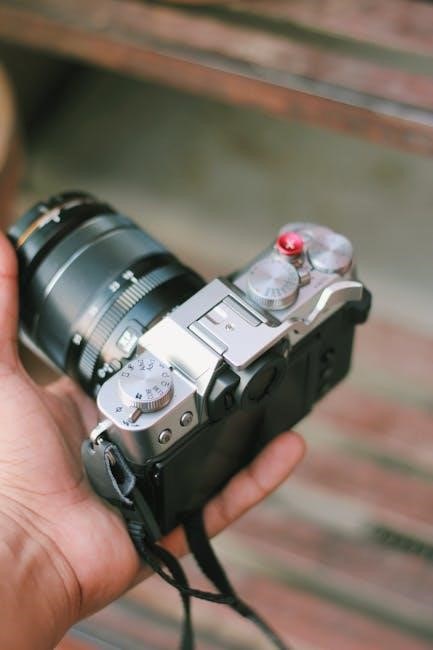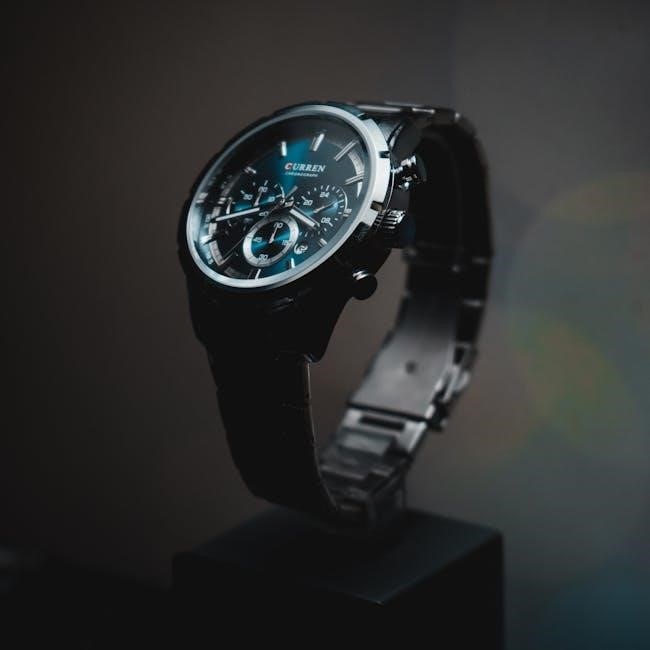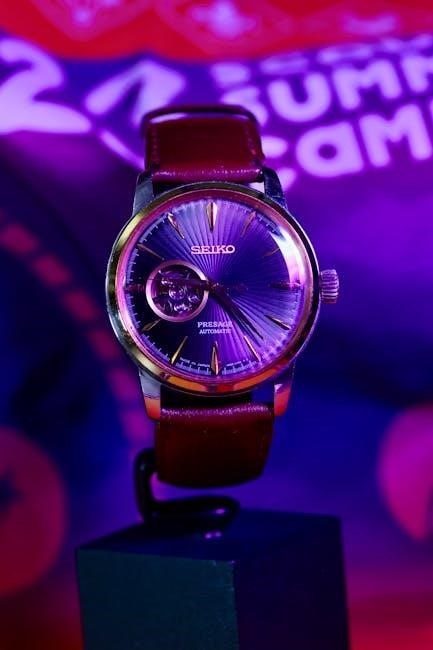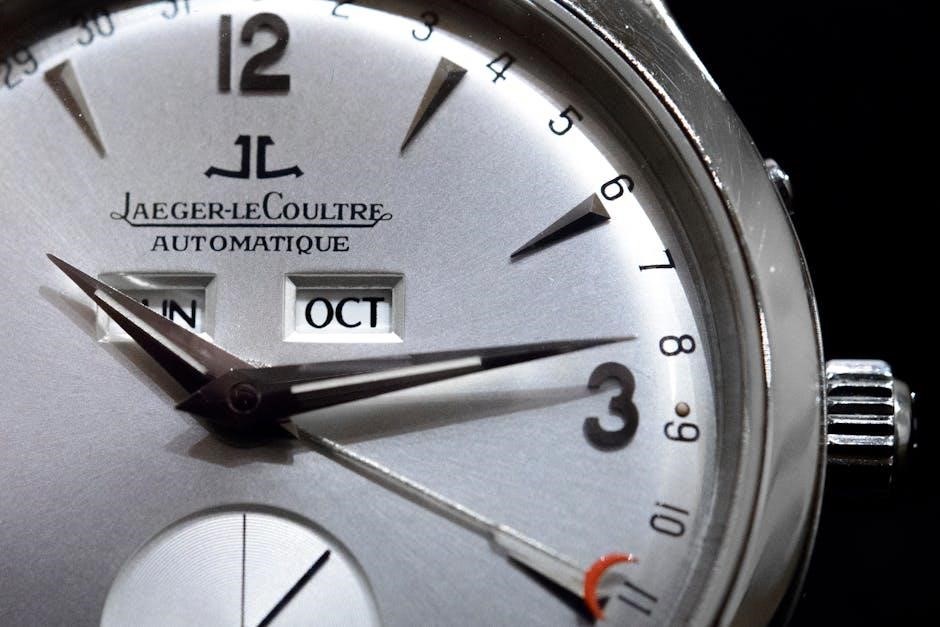Automatic and manual watches differ in how they are powered. Automatic watches use a rotor to wind the mainspring, while manual watches require daily winding by the wearer. Both offer unique advantages, with manual watches often appealing to those who value tradition and craftsmanship, and automatic watches providing convenience and modern engineering. Understanding their differences helps in choosing the right timepiece for personal preferences and lifestyle needs.
Overview of Watch Movements
Watch movements are the heart of timepieces, determining how they operate. Manual watches require the wearer to wind the mainspring daily, fostering a direct connection with the watch. This process involves turning the crown to store energy, which powers the movement. Automatic watches, however, use a rotor that winds the mainspring through wrist motion, eliminating the need for manual winding. Both movements are mechanical but differ in energy sourcing. Manual movements are often thinner due to the absence of a rotor, while automatic movements are thicker but more convenient. Understanding these movements helps enthusiasts appreciate the craftsmanship and functionality behind their timepieces.

Importance of Understanding the Differences
Understanding the differences between automatic and manual watches is crucial for making informed decisions. Manual watches appeal to those who value tradition and the tactile experience of winding, while automatic watches offer convenience for everyday wear. Knowing these distinctions helps in selecting a timepiece that aligns with personal preferences, lifestyle, and maintenance habits. Additionally, this knowledge enhances appreciation for the craftsmanship and engineering behind each type. Whether prioritizing aesthetics, functionality, or historical significance, understanding the unique aspects of each movement ensures a more meaningful connection with the watch. This awareness also aids in proper care and maintenance, extending the longevity of the timepiece.

History and Evolution
The origins of manual watches date back to early horology, emphasizing craftsmanship and tradition. Automatic watches emerged later, revolutionizing timekeeping with self-winding technology, blending innovation with practicality.
Origins of Manual Watches
Manual watches trace their roots to the early days of horology, representing the foundation of mechanical timekeeping. These timepieces require the wearer to manually wind the mainspring daily, fostering a personal connection between the wearer and the watch. The origins of manual watches are deeply tied to craftsmanship and tradition, with each piece showcasing the artistry of watchmaking. The tactile experience of winding the watch has enduring appeal, especially for those who appreciate historical significance and the tangible bond it creates. This traditional method has persisted, offering a timeless alternative to modern innovations like automatic watches.
Development of Automatic Watches
Automatic watches, also known as self-winding watches, were developed to eliminate the need for manual winding. The first practical automatic movement was invented in the 18th century by Swiss watchmaker Abraham-Louis Perrelet. However, it wasn’t until the 20th century that automatic watches became widely popular. The rotor, a oscillating weight, harnesses kinetic energy from wrist movements to wind the mainspring, providing a convenient and reliable power source. This innovation revolutionized watchmaking, offering a practical solution for everyday wear. Automatic watches are celebrated for their modern engineering and ease of use, making them a preferred choice for many watch enthusiasts seeking hassle-free timekeeping.
Key Innovations in Watchmaking
Watchmaking has seen remarkable advancements, particularly in automatic and manual watches. The introduction of the rotor in automatic watches eliminated the need for manual winding, while thinner movements in manual watches allowed for sleeker designs. Innovations in materials, such as titanium and advanced alloys, have improved durability and comfort. Additionally, the development of anti-magnetic and water-resistant technologies has enhanced performance. Modern watchmaking also emphasizes aesthetic innovations, like skeletonized movements and intricate engravings, blending artistry with functionality. These advancements have elevated both automatic and manual watches, catering to diverse preferences and lifestyles while preserving the craftsmanship that defines horology.

Design and Mechanics
Automatic watches feature a rotor for self-winding, adding thickness, while manual watches are slimmer without it, often showcasing intricate mechanics through a display back, emphasizing craftsmanship.

Manual Watch Movement: How It Works
A manual watch movement relies on a mainspring that stores energy when wound by turning the crown. This energy powers a gear train and escapement, measuring time. The process requires daily winding, fostering a direct connection between the wearer and the watch. The mainspring unwinds slowly, transferring energy through gears to the balance wheel, which oscillates to regulate timekeeping. Manual movements are often thinner due to the absence of a rotor, allowing for sleek designs. They also highlight the craftsmanship of traditional watchmaking, offering a tangible link to horological history. This mechanical simplicity appeals to purists who appreciate the art of winding their timepiece by hand.
Automatic Watch Movement: How It Works
An automatic watch movement harnesses energy from the wearer’s wrist movements to power its mainspring. A rotor, connected to the mainspring, oscillates with every motion, winding the spring and storing energy. This energy is then transmitted through a gear train to the balance wheel, which regulates timekeeping. Unlike manual watches, automatic movements eliminate the need for daily winding, offering convenience for everyday use. The rotor’s motion ensures the watch stays powered as long as it is worn, making it ideal for those who value practicality. This self-winding mechanism combines modern engineering with traditional horology, providing a seamless blend of functionality and craftsmanship.
Key Differences in Design
The design differences between automatic and manual watches are notable. Automatic watches feature a rotor, which adds thickness to the movement, while manual watches lack this component, allowing for slimmer designs. This makes manual watches ideal for those who prefer a more elegant, low-profile timepiece. Additionally, manual watches often showcase their intricate movements through display backs, as there is no rotor obscuring the view. Automatic watches, while slightly thicker, offer the convenience of a self-winding mechanism. These design distinctions cater to different aesthetic and functional preferences, with manual watches appealing to purists who appreciate traditional craftsmanship and automatic watches suiting those who value modern engineering and practicality.

Advantages and Disadvantages
Manual watches offer slim designs and a personal connection through daily winding but require consistent maintenance. Automatic watches provide convenience and reliability but are thicker and less traditional.
Pros of Manual Watches
Manual watches offer a unique charm and practical benefits. Their slimmer design, achieved without a rotor, makes them ideal for formal occasions. The ritual of daily winding fosters a personal connection, creating a sense of ownership and tradition. Additionally, manual watches often feature intricate craftsmanship visible through display backs, appealing to enthusiasts who appreciate horological art. They are also lightweight and timeless, making them a cherished choice for collectors. Furthermore, manual watches can be more affordable than automatics, offering excellent value for those who enjoy the tactile experience of winding. Overall, manual watches blend tradition, aesthetics, and craftsmanship, making them a beloved option for many watch enthusiasts.
Cons of Manual Watches
Manual watches require daily winding, which can be inconvenient for those with busy lifestyles. Forgetting to wind the watch can result in it stopping, making it unreliable for consistent timekeeping. Additionally, manual watches typically have a shorter power reserve, often lasting only 1-3 days, meaning they need frequent attention. This dependency on manual intervention can be a drawback for individuals seeking a low-maintenance timepiece. Furthermore, the constant need to wind the watch may lead to wear and tear on the crown and movement over time. While some enjoy the ritual, others find it a hassle, making manual watches less practical for everyday use compared to automatic watches.
Pros of Automatic Watches
Automatic watches offer unparalleled convenience, as they eliminate the need for daily winding. The rotor mechanism harnesses the wearer’s movements to wind the mainspring, ensuring consistent power delivery. This self-winding feature makes automatic watches ideal for individuals with busy lifestyles, as they require minimal maintenance. Additionally, automatic watches are often seen as marvels of modern engineering, combining functionality with aesthetic appeal. They also provide a seamless user experience, as they remain accurate and reliable without manual intervention. For those who appreciate innovation and practicality, automatic watches are a superior choice, offering both style and efficiency in a single timepiece.
Cons of Automatic Watches
Automatic watches have some drawbacks that may deter certain enthusiasts. The rotor mechanism can be prone to damage if dropped or exposed to harsh conditions, leading to costly repairs. Additionally, automatic watches are generally thicker than manual watches due to the rotor, which may not appeal to those who prefer sleek, minimalist designs. If the watch is not worn regularly, it can stop running, requiring manual winding to restart. Furthermore, some users find the necessity to manually wind an automatic watch when it runs out of power to be inconvenient. These factors highlight the trade-offs between convenience and maintenance in choosing an automatic watch.

Maintenance and Care
Manual watches require consistent winding to maintain power, fostering a personal connection with the timepiece. Automatic watches need less frequent intervention but still demand regular servicing to ensure optimal performance and longevity.
Maintaining a Manual Watch
Maintaining a manual watch involves regular winding to ensure consistent timekeeping. Typically, winding should occur daily, preferably at the same time, to prevent the mainspring from fully unwinding. Over-winding should be avoided, as it can strain the mechanism. Additionally, manual watches benefit from periodic servicing by a professional to clean and lubricate internal components, ensuring longevity. Unlike automatic watches, manual timepieces do not rely on wrist movement, making them more susceptible to power reserve depletion if neglected. Proper care fosters a lasting connection between the wearer and their timepiece, preserving its functionality and aesthetic appeal for generations.
Maintaining an Automatic Watch
Maintaining an automatic watch involves regular wear to keep the mainspring wound via the rotor’s motion. If not worn for extended periods, it should be stored in a cool, dry place or placed on a watch winder to maintain power. Servicing every 4-6 years is essential to clean and lubricate the movement, ensuring optimal performance. Unlike manual watches, automatics require less direct interaction but benefit from periodic professional care. Proper maintenance extends the watch’s lifespan and preserves its accuracy and aesthetic appeal, making it a reliable companion for everyday use or special occasions.
Common Mistakes to Avoid
When caring for automatic and manual watches, several common mistakes should be avoided. Over-winding is a frequent error, as it can damage the mainspring. For automatic watches, not winding manually when necessary can lead to power reserve depletion. Neglecting regular servicing is another mistake, as it can result in poor timekeeping and mechanical issues. Improper storage, such as exposing the watch to extreme temperatures or humidity, can harm the movement; Additionally, failing to wind a manual watch daily can cause it to stop running. Avoiding these mistakes ensures the longevity and optimal performance of both automatic and manual timepieces, preserving their craftsmanship and functionality for years to come;

Practical Considerations
Practical considerations for choosing between automatic and manual watches include lifestyle, convenience, and personal preference. Manual watches suit formal events due to their slim design, while automatic watches offer everyday convenience with self-winding functionality, catering to different needs and preferences effectively.
Everyday Use of Manual Watches
Manual watches require daily winding, creating a ritualistic bond between the wearer and the timepiece. This hands-on interaction fosters a sense of connection and appreciation for craftsmanship. Their thinner design makes them ideal for formal occasions, while their mechanical simplicity appeals to purists. However, they demand consistent attention, as forgetting to wind them can halt their function. Despite this, many enthusiasts find the process rewarding, valuing the tactile experience and the satisfaction of keeping their watch accurate. For those who cherish tradition and are willing to invest time, manual watches offer a unique and intimate ownership experience that stands out in a fast-paced world.

Everyday Use of Automatic Watches
Automatic watches are designed for convenience and everyday wear. They harness the wearer’s wrist movements to wind the mainspring, eliminating the need for daily manual winding. This makes them ideal for individuals with busy lifestyles or those who prefer a hassle-free experience. Their self-winding mechanism ensures consistent accuracy and reliability. However, automatic watches may be slightly thicker due to the rotor, which can be a consideration for some users. For those who value practicality and modern engineering, automatic watches offer a seamless blend of functionality and style, making them a popular choice for both casual and formal settings.
Choosing the Right Watch for Your Lifestyle
Choosing between an automatic and manual watch depends on personal preferences, lifestyle, and practical needs. Manual watches appeal to those who appreciate tradition, craftsmanship, and the tactile experience of winding. They are ideal for collectors or individuals who value the ritual of daily interaction with their timepiece. Automatic watches, on the other hand, are perfect for everyday wear, offering convenience and reliability without the need for manual winding. Consider factors like frequency of use, desired thickness of the watch, and design aesthetics. Ultimately, the decision comes down to whether you prioritize tradition and personal connection or modern convenience and practicality in your timekeeping companion.

Automatic and manual watches each offer unique charm and functionality, catering to different preferences and lifestyles. The choice between them ultimately depends on personal taste and practical needs.
Final Thoughts on Automatic vs Manual Watches
When deciding between automatic and manual watches, consider lifestyle and personal preference. Automatic watches offer convenience, winding automatically with wrist movement, ideal for everyday wear. Manual watches, requiring daily winding, appeal to those who cherish tradition and craftsmanship. Both types are durable with proper care. Automatics are thicker due to the rotor, while manuals are slimmer. Display backs reveal different mechanics: rotors for automatics and intricate movements for manuals. Ultimately, the choice reflects individual values—whether prioritizing modern engineering or embracing timeless tradition. Each watch type fosters a unique connection, making them timeless companions for watch enthusiasts.
Recommendations for Watch Enthusiasts
For watch enthusiasts, the choice between automatic and manual watches depends on personal preferences and lifestyle. If convenience and modern engineering appeal to you, automatic watches are ideal. They require minimal maintenance and are perfect for everyday wear. On the other hand, manual watches offer a tactile experience, fostering a deeper connection with the timepiece. They are a great choice for those who appreciate tradition and craftsmanship. Consider your daily routine and how often you plan to wear the watch. Additionally, budget and brand preferences should guide your decision. Both types are excellent investments, so prioritize what resonates most with your values and style.
